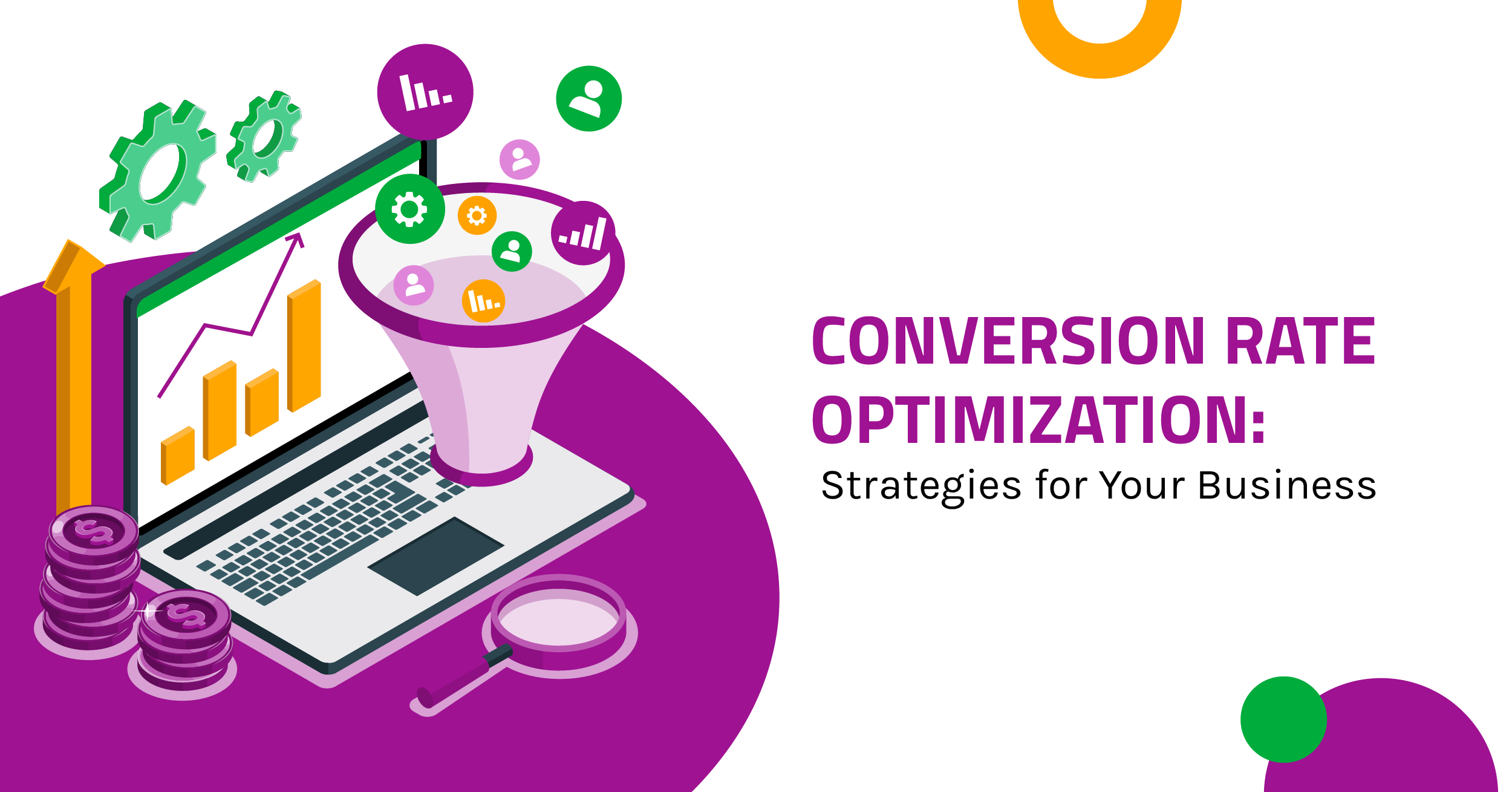Conversion Rate Optimization: Strategies for Your Business

If you feel like your page isn’t gaining more visitors, it might be the lack of conversion rate optimization (CRO). Great content can only do so much; it should be optimized to increase the percentage of the page’s visitors. But don’t fret! Here’s a quick guide on what you need to know about CRO.
What is conversion rate optimization?
Before we dive into CRO and what it can do, let’s explore each part step by step:
Conversion
Conversion is the term used when referring to the moment when a user completes a website goal. The goals of each website vary; there’s no general goal for all. For example, if your website is meant to sell your products, its goal is for the website visitor to make a purchase. If your website promotes an event, its goal is for the website visitor to sign up for it. These primary goals are called macro-conversions.
On the other hand, smaller conversions can occur before the user does the macro-conversion. These are referred to as micro-conversions.
Examples of macro-conversions:
- Completing an application form
- Signing up as a member
- Subscribing to a service
Examples of micro-conversions:
- Adding a product to the online shopping cart
- Watching a video
- Creating an account
Conversion rate
A conversion rate is the number of times your website visitor completes a goal, divided by your site traffic. To put it simply, it’s the number of conversions divided by the total number of website visitors. Multiply this figure by 100 to get a percentage.
For example, if your website garnered 50 signups to your newsletter and there were 300 visitors, your computation would be:
(50/300) x 100 = 16.67%
This would mean that your conversion rate is 16.67%.
Knowing your conversion rate allows you to benchmark how your website is performing. It makes it easier for you to track the results of any changes you make as well.
Conversion rate optimization
Conversion rate optimization is the process of increasing the number of users who do a certain action. It’s a strategic approach that is done to increase the percentage of those who followed the call to action.
Why does CRO matter?

Photo by Thought Catalog on Unsplash
With CRO, you get more value from the website visitors that you already have. Implementing conversion rate optimization techniques helps you increase revenue per visitor and get more customers. Other benefits of CRO are the following:
- You get to leverage existing website traffic
You don’t necessarily need fresh traffic on your site to increase your conversions. Simply optimize the website for your current customers and use your existing marketing strategy.
Instead of focusing on first-time website visitors, design a CRO-focused website applicable to all users. Even small, key changes to the website can convert existing traffic. This strategy will engage with returning visitors and motivate them to convert. - You get a better return on investment (ROI)
Having a high conversion rate means getting more bang for your buck. You get to generate more customers without increasing your budget because you’re simply making the most of the resources that you have. - There’s better scalability
The right conversion rate optimization strategies will allow you to grow without running out of potential customers. Even though markets only have a limited pool of prospects, you can still make the most out of them and turn your visitors into customers.
Let your CRO strategy help you make the most out of your existing audience by impressing them with your service, UX, and UI, to name a few. It will turn your browsers into buyers in a matter of time. - You get to know your customers and earn their trust
Meeting your customers’ needs means being dedicated to finding a solution to their problems. CRO will help you get a fuller picture of those who visit your website—which, in turn, will allow you to see how you can improve the user experience based on what they look for.
When you dedicate time and effort to addressing your potential customers’ concerns, you’ll also be able to earn their trust. Besides, no website visitor will give their name, email address, and contact details to a sketchy-looking website. A professional-looking site with a strong CRO strategy tells your website visitors that your website can be trusted. - You provide a better user experience
Website visitors will likely stick around if they feel welcome and at ease on your website. CRO analyzes what works on your site so you can give your visitors the best user experience. If your website makes them feel that they’re valued visitors, they’ll engage with it even more. Thus, you’ll have higher chances of gaining new customers.
How do I get started with CRO?
It may sound complicated, but CRO is as easy as PIE—and by “PIE,” we mean the PIE framework.
To get started with CRO, prioritize your efforts by ranking each element on its:
- Potential
- Importance
- Ease
With this framework, answer the following questions for each CRO strategy:
- How much overall improvement can this project offer?
- How important will the improvement be?
- What’s the level of difficulty in implementing this improvement?
According to HubSpot, you must assign a score of 1 to 10 for each CRO strategy. Once you've given a score for each strategy, add them up and divide the total by three. This score will show which project will have the greatest impact. Prioritize the projects with the highest scores.
Remember: The PIE framework is helpful in identifying which strategy is more important based on the score.
The whole process of CRO is as follows:
- Gather data
The research and data-gathering phase is the first step in the CRO process. Keep in mind that an effective strategy for one website may not be effective for yours, so do not copy another’s CRO strategy.
Gather data and understand how users are reacting to your site and why. This can be quantitative data that will help you see how your visitors are reacting to your site (e.g., demography, bounce rate) or qualitative data that shows why your users are behaving a certain way (e.g., data from polls and surveys).
Use data-backed decisions to track conversions and do the necessary analyses. - Hypothesize
Based on the data you’ve collected, your next step is to form your hypothesis, such as “If we add messages like ‘only 5 pieces left!’ or ‘low in stock,’ we develop a sense of urgency and can have a 5% increase in orders.’” Remember that your hypothesis must be based on statistical data.
With your hypothesis, you must then implement the changes through A/B tests and multivariate testing. But before that, you must know what to prioritize. - Prioritize
Know which ideas and hypotheses to prioritize and focus on the most important problems first.
We recommend going back to the PIE framework so you can easily rank and prioritize all your ideas based on the average score of each. - Test and implement
Now that you have your data, hypothesis, and prioritization, you may now test and implement them in three ways:
A/B testing — This is a research methodology that tests user experience between variants A and B. You can use this method to test optimizations like titles and minor layout tweaks.
Split testing — This method tests more complex changes. It’s used to compare two different variations of a page with separate URLs.
Multivariate testing — You may use this method when you need to make multiple changes on a page and test each combination separately. - Learn and review
With your test results now ready, you’ll either discover that your hypothesis is correct or it didn’t turn out as you expected. If the test results come out positive, you can apply the changes right away. If not, you may form new hypotheses.
What are the best practices and strategies in CRO?
Conversion rate optimization is not just a process. It involves best practices and strategies for you to get the best results possible. Make sure these tips and strategies are part of your conversion rate optimization checklist.
Conversion rate optimization tips and best practices
- Use data, not feelings
Do not assess your website performance through what you just think or feel. Use data based on insights from tools like Google Analytics so you can get factual and actionable information (e.g., bounce rate) in real time. - Have clear goals
Having clear goals can help you track your progress. Make sure your goals are SMART (Specific, Measurable, Achievable, Relevant, and Time based). For example, your goal shouldn’t just be “I aim to have more customers.” Define it further: “I aim to have X% more customers by [this specific timeframe] by doing [this strategy].” - Know your audience
The size of your audience will only be meaningful if you know them. Create buyer personas that align with your various visitors and optimize your content to better fit their needs. - Don’t copy the competition
As mentioned earlier, an effective strategy for one website may not be effective for yours, so don’t resort to simply copying the competition. However, you may use them as a resource to find out the elements that convince your industry audience to convert and explore your competitors’ sites. Don’t copy—analyze what makes things work and find what works for you. - Do A/B and multivariate testing
A/B testing helps you compare different elements on two pages, while multivariate testing determines how variations across various page sections would perform when combined. Both of these methods can help you clearly see which optimization efforts will work best.
Conversion rate optimization examples and strategies
- Have CTAs within blog posts
Calls to action (CTAs) tell readers what they need to do next. When your blog posts have CTAs—and we recommend text-based CTAs—you direct your audience to the right action and eliminate decision fatigue. - Deepen engagement in high-converting web pages
Add messaging features such as live chat software to your high-performing web pages such as product pages. That way, leads can get the information they need in real time. You can also have action-based chatbots. - Add lead flows to your blogs
Lead flows are pop-ups meant to attract attention. You can use a drop-down banner, pop-up box, or slide-in box—whichever is best for your offer. - Develop workflows
With tools like marketing automation software, you can develop automated workflows that can enable your team. For example, workflows can send automatic emails to leads. These leads can then book meetings with sales representatives. - Do tests on your landing pages
A landing page is a page that visitors immediately go to after clicking links in search engine results, social media ads, or email marketing campaigns. Optimize a landing page by running A/B tests. - Retarget and re-engage website visitors
Retargeting is when you track visitors to your website and serve them some ads when they visit other sites. This has the most impact when you retarget those who went to your highest-converting web pages. That way, you encourage them to go back to your website and complete a goal. - Turn leads into marketing-qualified leads
There are times when website visitors skip parts of the buyer’s journey. Instead of being nurtured, they immediately jump to speaking with a sales representative. When this happens, there are certain actions that you encourage them to take so they can become marketing-qualified leads (MQLs).
These actions can be through webpages, compelling copy, emails, and CTAs. - Optimize blog posts
You don’t always have to create blog posts from scratch. Optimize your blogs by identifying the posts with the highest levels of web traffic but low conversion rates. Figure out what causes these. Is it weak SEO? Is it a poorly written CTA?
You may also check out your blogs with high conversion rates. Optimize the content for the search engine results page (SERP) or update it whenever necessary to keep it relevant.
Great content works best with optimization. With the right CRO strategies, your website won’t just gain more visitors, but also gain satisfied customers for your business.
Let’s talk about your CRO strategy. Check out our services and send us a message!








Comments